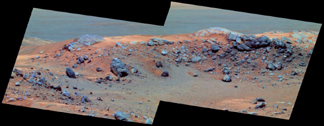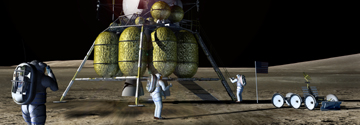
The Mars Exploration rovers Spirit and Opportunity have spent 664 and 644 sols
(Mars days) respectively on the red planet, as of Nov. 15, well beyond their
expected one-year lifetimes. Their travels have provided a wealth of data on
water, soils and other geologic characteristics, in particular the presence
of goethite, nodular “blueberries” (first discovered last year by
Opportunity) and other evidence for  settings
that may have held shallow lakes or were saturated with water in the past. The
rovers have also overcome a variety of obstacles — from big boulders and
a damaged wheel on Spirit, to diminished power from their solar panels, coated
by Mars’ dust. See the Geotimes
online archive for this year’s rover news.
settings
that may have held shallow lakes or were saturated with water in the past. The
rovers have also overcome a variety of obstacles — from big boulders and
a damaged wheel on Spirit, to diminished power from their solar panels, coated
by Mars’ dust. See the Geotimes
online archive for this year’s rover news.
The Mars Exploration Rover Spirit took this panorama of Mars’ very own
“Mount Everest,” a 106-meter-high hilltop, on its 608th martian day
(Sept. 18). Image courtesy of NASA/JPL-Caltech/Cornell.
Back to top
Announcements this year of two planet-like bodies discovered orbiting the sun
— one with a moon — have many astronomers rethinking the definition
of “planet.” These newest celestial neighbors are fueling the debate
about which planetary bodies qualify for the term.
Mike Brown of Caltech in Pasadena, Calif., announced the discovery of a body
larger and farther out than Pluto, in a debris reservoir called the Kuiper Belt.
Brown and colleagues first imaged 2003 UB313 (nicknamed Xena by astronomers,
after the TV show’s warrior princess) in October 2003, but its motion remained
undetected until January. “We are 100 percent confident that this is the
first object bigger than Pluto ever found in the outer solar system,” Brown
said in a Sept. 29 NASA press release. Depending on planetary definitions, the
body may be considered the 10th planet in our solar system.
A new moon discovered orbiting 2003 UB313 (nicknamed Gabrielle, after Xena’s
sidekick) further complicated its planetary status. Initial estimates indicate
that the moon is about one-tenth the size of its host and that it completes
an orbit once every few weeks. “Having a moon is just inherently cool —
and it is something that most self-respecting planets have, so it is good to
see that this one does too,” Brown said in a Sept. 30 Caltech press release.
Also fighting for planetary status is Ceres: Once considered the solar system’s
largest asteroid, scientists have recently discovered that it is remarkably
round, implying that distinct layers may compose its interior — a planetary
characteristic not found in asteroids. The Hubble Space Telescope captured the
images of Ceres, and researchers published an analysis in the Sept. 8 Nature,
saying that gravitational tugs on the “embryonic” planet, located
in the asteroid belt between Mars and Jupiter, prevented it from developing
into a full-fledged planet. The Texas-sized object is 14 times less massive
than Pluto.
Comparing new discoveries to Pluto, however, will not likely be sufficient to
determine planetary status for the new objects, as not all astronomers consider
Pluto a planet. The International Astronomical Union (IAU) charged an expert
panel, led by Iwan Williams of University of London, to consider the terminology,
which included the option of dropping the term all together, according to a
Sept. 22 Nature news story. Other options included using categories such
as “Trans-Neptunian planets,” “terrestrial planets” and
“gas giants.” As of November, Williams says that the panel sent three
possible definitions to the IAU executive committee for a decision.
At the end of October, scientists announced the discovery of two more moons
for Pluto — drawing more attention to Pluto’s planetary status.
Kathryn Hansen
Links:
"Two more moons for Pluto,"
Geotimes online, Web Extra, Nov. 3, 2005.
Back to top
Back to space
 Almost
two years have passed since President Bush announced his new vision for space
exploration, which called for sending humans to the “moon, Mars and beyond.”
Now, to stay on schedule, NASA has four years to complete the International
Space Station and retire the space shuttle, eight years to develop and fly its
new exploration vehicle, and 14 years to return to the moon.
Almost
two years have passed since President Bush announced his new vision for space
exploration, which called for sending humans to the “moon, Mars and beyond.”
Now, to stay on schedule, NASA has four years to complete the International
Space Station and retire the space shuttle, eight years to develop and fly its
new exploration vehicle, and 14 years to return to the moon.
NASA recently unveiled its plans to return to the moon, presenting illustrations
of a new lunar lander, which will accommodate four crew members. The new system
will not require an astronaut to remain in orbit while the others explore the
surface, as was the case with the Apollo missions. Image courtesy of NASA.
As part of the plan, this year, NASA undertook the first shuttle launch since
the February 2003 Columbia tragedy, and completed blueprints for a “retro”
spacecraft to return astronauts to the moon. But advances this year were not
without a number of technical, political and weather-related obstacles.
NASA faced a reshuffling of personnel starting on April 14, when the U.S. Senate
confirmed Michael Griffin as the agency’s new administrator. Griffin replaced
Sean O’Keefe, who resigned from the position in February. Griffin said
that he planned to focus immediately on the “Return to Flight” mission,
which would put the shuttles back in service after two and a half years on the
ground.
On July 16, Discovery “returned to flight” after a 13-day delay
to fix a faulty fuel sensor. During its launch, however, cameras recorded a
chunk of foam detaching from the shuttle’s external fuel tank — a
similar event led to the Columbia disaster.
Inspection of the shuttle’s exterior revealed no damage from the foam,
but images did reveal filler material protruding from between the protective
tiles, which engineers thought might compromise safety during the shuttle’s
reentry. Astronauts remedied the problem during a spacewalk — the first
ever heat-shield repair to be done in space — and safely returned to Earth
on Aug. 8.
Following the mission, NASA ordered that the shuttles remain grounded for further
testing, and no additional launches are planned until March 4, 2006, at the
earliest. “We are giving ourselves what we hope is plenty of time to evaluate
where we are,” Griffin said in an Aug. 18 NASA press release. “We
don’t see the tasks remaining before us being as difficult as the path
behind us.”
More obstacles came from hurricanes that struck in the vicinity of three NASA
facilities this fall, momentarily halting preparation of the three shuttles
for future flights. The Aug. 29 landfall of Hurricane Katrina ravaged buildings
of the Michoud facility located east of New Orleans. Most of the external fuel
tanks, manufactured at Michoud, escaped relatively unscathed. Damage to NASA
facilities, however, were estimated to reach more than $1 billion.
In preparation for the Sept. 24 landfall of Hurricane Rita, the Johnson Space
Center in Houston, Texas, turned over control of the International Space Station
to Russian mission control, so that employees could evacuate. The center fared
well through the storm with little to no damage, and reopened on Sept. 27, but
NASA officials said it was too soon to know how the storms will affect the March
launch date of Discovery.
If the future launch of Discovery is successful, then a following mission
aboard Atlantis will carry components needed to resume assembly of the
space station. After completion of the station planned for 2010, the shuttles
will be retired indefinitely.
Until the space shuttles can reliably make flights to the space station, NASA
is counting on the Russian Soyuz spacecraft to transport American astronauts
and materials — an arrangement that could come to an end, Griffin said
on Sept. 30, according to an Associated Press story. Russia has requested payment
for seats aboard Soyuz starting with the next mission in April 2006,
but the Iran Nonproliferation Act prevents the exchange of money with countries
that aid Iran with weapons and missile technology. (Russia is helping Iran build
a nuclear power plant.) Congress, however, amended the act to allow the payments,
which Griffin said in a Nov. 9 NASA press release will ensure the continued
presence of U.S. astronauts aboard the space station.
In the meantime, NASA is working on a new craft to replace the shuttle. Blueprints
for the Next Generation Spacecraft unveiled on Sept. 19 were reminiscent of
the Apollo capsules of the 1960s. The capsule would be launched atop a “shuttle-derived”
rocket — a design that Griffin said “will build upon the foundation
of the proven designs and technologies used in the Apollo and space shuttle
programs.”
Some critics have questioned whether the United States should fund the mission
in the midst of a costly recovery from Hurricane Katrina; NASA estimates a price
tag of $104 billion, to make the first manned lunar mission in the new spacecraft.
Griffin responded by emphasizing that space exploration is a long-term investment.
“When we have a hurricane, we don’t cancel the Air Force, we don’t
cancel the Navy, and we’re not going to cancel NASA,” Griffin said.
Kathryn Hansen
Links:
"NASA on deck,"
Geotimes, May 2005.
"Discovery
returns to flight," Geotimes online, Web Extra, July 26, 2005.
"Shuttle repair
rundown," Geotimes online, Web Extra, Aug. 4, 2005.
"Space administration
shakeup," Geotimes, August 2005.
 |
Geotimes Home | AGI Home | Information Services | Geoscience Education | Public Policy | Programs | Publications | Careers |